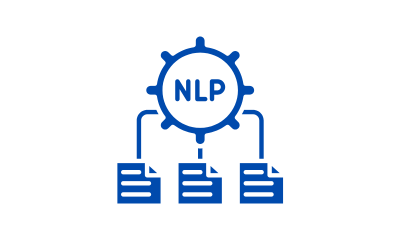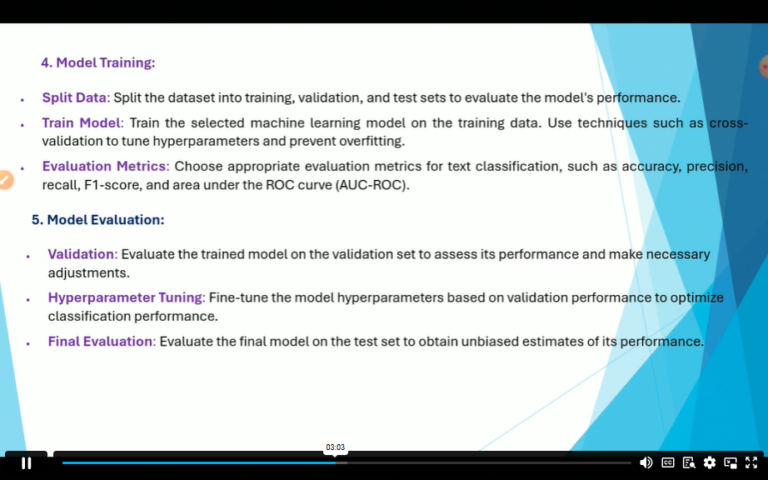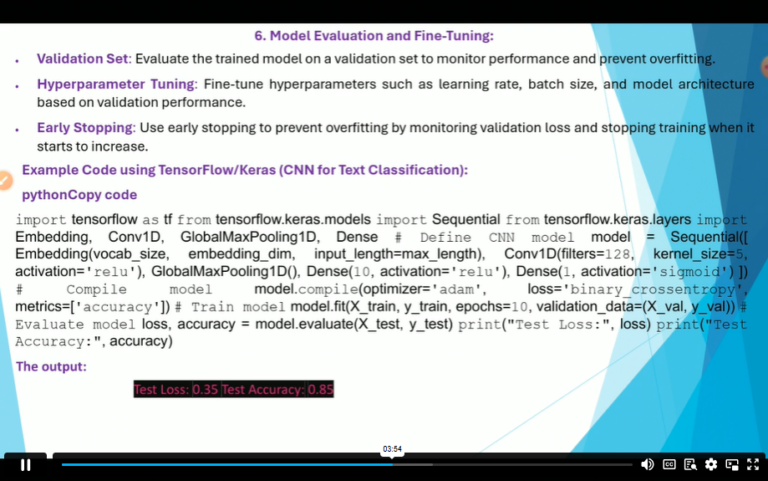Course Curriculum
| Certification in Natural Language Processing (NLP) | |||
| Module 1: Introduction and study plan | 00:03:00 | ||
| Module 2: Introduction to Natural Language Processing | 00:05:00 | ||
| Module 3: Text Processing | 00:07:00 | ||
| Module 4: Discourse and Pragmatics | 00:05:00 | ||
| Module 5: Application of NLP | 00:06:00 | ||
| Module 6: NLP is a rapidly evolving field | 00:03:00 | ||
| Module 7: Basics of Text Processing with python | 00:06:00 | ||
| Module 8: Python code | 00:06:00 | ||
| Module 9: Text Cleaning | 00:06:00 | ||
| Module 10: Python code | 00:07:00 | ||
| Module 11: Lemmatization | 00:12:00 | ||
| Module 12: TF-IDF Vectorization | 00:04:00 | ||
| Module 13: Text Representation and Feature Engineering | 00:03:00 | ||
| Module 14: Tokenization | 00:03:00 | ||
| Module 15: Vectorization Process | 00:03:00 | ||
| Module 16: Bag of Words Representation | 00:03:00 | ||
| Module 17: Example Code using scikit-Learn | 00:05:00 | ||
| Module 18: Word Embeddings | 00:04:00 | ||
| Module 19: Distributed Representation | 00:07:00 | ||
| Module 20: Properties of Word Embeddings | 00:10:00 | ||
| Module 21: Using Work Embeddings | 00:13:00 | ||
| Module 22: Document Embeddings | 00:04:00 | ||
| Module 23: purpose of Document Embeddings | 00:07:00 | ||
| Module 24: Training Document Embeddings | 00:04:00 | ||
| Module 25: Using Document Embeddings | 00:12:00 | ||
| Module 26: Continuation of Using Document Embeddings | 00:04:00 | ||
| Module 27: Supervised Learning for Text Classification | 00:08:00 | ||
| Module 28: Model Selection | 00:10:00 | ||
| Module 29: Model Training | 00:06:00 | ||
| Module 30: Model Deployment | 00:08:00 | ||
| Module 31: Continuation of Model Deployment | 00:03:00 | ||
| Module 32: Deep Learning for Text Classification | 00:08:00 | ||
| Module 33: Convolutional Neural Networks | 00:09:00 | ||
| Module 34: Transformer Based Model | 00:10:00 | ||
| Module 35: Model Evaluation and fine tuning | 00:07:00 | ||
| Module 36: Continuation of Model Evaluation and fine tuning | 00:04:00 | ||
| Module 37: Named Entity Recognition and Parts of Speech Tagging | 00:05:00 | ||
| Module 38: Named Entity Recognition | 00:04:00 | ||
| Module 39: Part of Speech Tagging | 00:05:00 | ||
| Module 40: Relationship Between NER and POS Tagging | 00:06:00 | ||
| Module 41: Syntax and parsing in NLP | 00:05:00 | ||
| Module 42: Syntax | 00:06:00 | ||
| Module 43: Grammar | 00:05:00 | ||
| Module 44: Application in NLP | 00:05:00 | ||
| Module 45: Challenges | 00:06:00 | ||
| Module 46: Dependency Parsing | 00:06:00 | ||
| Module 47: Dependency Relations | 00:04:00 | ||
| Module 48: Dependency Parse Trees | 00:06:00 | ||
| Module 49: Applications of Dependency Parsing | 00:05:00 | ||
| Module 50: Challenges | 00:10:00 | ||
| Module 51: Basics of Sentiment Analysis and Opinion Mining | 00:06:00 | ||
| Module 52: Understanding Sentiment | 00:12:00 | ||
| Module 53: Sentiment Analysis Techniques | 00:05:00 | ||
| Module 54: Sentiment Analysis Application | 00:05:00 | ||
| Module 55: Challenges and Limitations | 00:07:00 | ||
| Module 56: Aspect-Based Sentiment Analysis | 00:05:00 | ||
| Module 57: Key Components | 00:09:00 | ||
| Module 58: Techniques and Approaches | 00:03:00 | ||
| Module 59: Application | 00:08:00 | ||
| Module 60: Continuation of Application | 00:04:00 | ||
| Module 61: Machine Translation | 00:05:00 | ||
| Module 62: Types of Machine Translation | 00:08:00 | ||
| Module 63: Training NMT Models | 00:09:00 | ||
| Module 64: Challenges in Machine Translation | 00:04:00 | ||
| Module 65: Application of Machine Translation | 00:05:00 | ||
| Module 66: Language Generation | 00:05:00 | ||
| Module 67: Types of Language Generation | 00:09:00 | ||
| Module 68: Applications of Language Generation | 00:05:00 | ||
| Module 69: Challenges in Language Generation | 00:09:00 | ||
| Module 70: Future Directions | 00:07:00 | ||
| Module 71: Text Summarization and Question Answering | 00:07:00 | ||
| Module 72: Text Summarization | 00:11:00 | ||
| Module 73: Question Answering | 00:06:00 | ||
| Module 74: Techniques and Approaches | 00:06:00 | ||
| Module 75: Application | 00:05:00 | ||
| Module 76: Challenges | 00:07:00 | ||
| Module 77: Advanced Topics in NLP | 00:04:00 | ||
| Module 78: Recurrent Neural Networks | 00:04:00 | ||
| Module 79: Transformer | 00:06:00 | ||
| Module 80: Generative pre trained Transformer(GPT) | 00:06:00 | ||
| Module 81: Transfer LEARNING AND FINE TUNING | 00:04:00 | ||
| Module 82: Ethical and Responsible AI in NLP | 00:08:00 | ||
| Module 83: Transparency and Explainability | 00:09:00 | ||
| Module 84: Ethical use Cases and Application | 00:10:00 | ||
| Module 85: Continuous Monitoring and Evaluation | 00:06:00 | ||
| Module 86: NLP Application and Future Trends | 00:04:00 | ||
| Module 87: Customer service and Support Chatbots | 00:08:00 | ||
| Module 88: Content Categorization and Recommendation | 00:08:00 | ||
| Module 89: Voice Assistants and Virtual Agents | 00:05:00 | ||
| Module 90: Healthcare and Medical NLP | 00:09:00 | ||
| Module 91: Future Trends in NLP | 00:07:00 | ||
| Module 92: Multimodal NLP | 00:07:00 | ||
| Module 93: Ethical and Responsible AI | 00:09:00 | ||
| Module 94: Domain Specific NLP | 00:09:00 | ||
| Module 95: Continual Learning and Lifelong Adaptation | 00:03:00 | ||
| Module 96: Capstone Project | 00:05:00 | ||
| Module 97: Project Components | 00:10:00 | ||
| Module 98: Model Selection and Training | 00:10:00 | ||
| Module 99: Deployment and Application | 00:16:00 | ||
| Module 100: Assessment Criteria | 00:11:00 | ||
| Module 101: Additional Resources and Practice | 00:04:00 | ||
| Module 102: Assignment | 00:01:00 | ||
Instructors
2 STUDENTS ENROLLED
 Food Hygiene
Food Hygiene Health & Safety
Health & Safety Safeguarding
Safeguarding First Aid
First Aid Business Skills
Business Skills Personal Development
Personal Development







